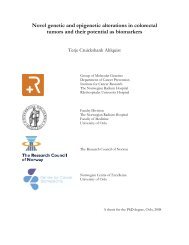Preface - Ous-research.no
Preface - Ous-research.no
Preface - Ous-research.no
You also want an ePaper? Increase the reach of your titles
YUMPU automatically turns print PDFs into web optimized ePapers that Google loves.
Plastic and reconstructive surgery<br />
Leader<br />
Kim Alexander Tønseth, MD, PhD (OUH /UiO)<br />
Scientific staff<br />
Hans Erik Høgevold, MD, PhD (OUH)<br />
Christian Korvald, MD, PhD (OUH)<br />
Cathrine Wold Knudsen, MD, PhD (OUH)<br />
Thomas Moe Berg, MD, PhD (OUH)<br />
Tyge Tindholdt, MD, PhD-student (OUH)<br />
Christian Sneistrup, MD (OUH)<br />
Said Saidian, MD (OUH)<br />
Kim Alexander Tønseth<br />
Department Chairman<br />
Introduction<br />
Plastic and reconstructive surgery is performed to restore<br />
<strong>no</strong>rmal anatomy and function in patients with congenital<br />
and acquired disorders, and in patients with tissue defects<br />
after trauma or cancer surgery. During the last decades<br />
<strong>research</strong> in plastic and reconstructive surgery has led to<br />
development of a large number of treatment options for<br />
patients with different kinds of disorders and defects. These<br />
methods are often based on experimental <strong>research</strong> which<br />
has been refined through clinical procedures. The main<br />
outcome is improved quality of life and patient satisfaction<br />
based on restoration of a<strong>no</strong>malies and dysfunction.<br />
Research areas<br />
Free tissue transfer is a relatively new technique which<br />
has revolutionized the field of reconstructive surgery over<br />
the past three decades. During the 1970s, reconstructive<br />
surgeons started to use the microscope to perform anastomosis<br />
of small vessels (±1mm). Tissue, based on these<br />
small vessels, could be transposed from a distant part of<br />
the body (do<strong>no</strong>r site) to the location where reconstruction<br />
was needed and the vessels anastomosed to a recipient<br />
artery and vein. In 1989 a new area of free flap surgery was<br />
initiated with the introduction of flaps based on perforator<br />
vessels. This technique improved reconstruction by reducing<br />
do<strong>no</strong>r site morbidity and by allowing new alternative<br />
flap designs. There is a constant need for optimising the<br />
reconstruction techniques to give the best possible result<br />
with minimal disadvantages at the do<strong>no</strong>r site. Our <strong>research</strong><br />
group has focused on the following areas:<br />
1. Microcirculation in random flaps on rats<br />
In order to investigate the distribution of blood and<br />
microcirculation in random flaps we have designed a rat<br />
model that enables us to perform multiple measurements<br />
with laser Doppler perfusion imaging (LDPI; see below). A<br />
random flap is raised with width-length proportions of 1:5.<br />
The flap is monitored in 5 equally sized squares on which a<br />
LDPI measurement is performed every hour for 6 hours. The<br />
circulation is then evaluated with regards to the blooddistribution<br />
within the flap.<br />
2. The effect of prostaglandin E1 on microcirculation<br />
Several studies suggest a positive effect of prostaglandin<br />
E1 (PGE1) on the circulation of flaps. In the same rat model<br />
as described above we compare the circulation of random<br />
flaps with i.v. infusion of PGE1 alternative saline and perform<br />
LDPI measurement. The flap is monitored in 5 equally sized<br />
squares on which a LDPI measurement is performed every<br />
hour for 6 hours (fig 1). The circulation is then evaluated<br />
for every square and comparison between the control and<br />
intervention groups is performed and verified statistically.<br />
Figure 1. A LDPI scan after<br />
raising the random flap based<br />
cranially. Perfusion is measured<br />
in the five zones.<br />
47
















